April 7, 2020
Proclaiming the liberation narrative of God through church art

A portion of the North Star window at Chicago's New Mount Pilgrim Missionary Baptist Church. It represents the great migration of African Americans leaving the South and includes images of the church's longest-serving pastors. Photo by Eric Allix Rogers
A Chicago church has installed a trio of stained-glass windows to help its members reclaim their past, honor their present and look ahead to their future.
The praise dancers, dressed in black, moved in a sea of color, surrounded by the jewel tones of the sanctuary’s rose windows and the parishioners’ attire. In a space now shared with their ancestors, the girls embodied the strength and resilience they had inherited, their choreographed movements amplifying the message of a song from the movie “Harriet.”
“I’m gonna stand up, take my people with me … I hear freedom calling, calling me to answer.”

Members of Chicago’s New Mount Pilgrim Missionary Baptist Church, where the young women danced, are well-practiced in telling their story through art. That includes the trio of 25-foot rose windows, through which the church has embraced the tradition of stained glass as a teaching tool while depicting the unexpected.
What kinds of art — visual, musical, dramatic, etc. — tell the story of your institution?
The Maafa Remembrance, North Star and Sankofa Peace windows capture narratives from the past and present. In this season when the Christian church celebrates resurrection, the people of New Mount Pilgrim visibly honor both pain and promise through them in ways that are heartbreaking, breathtaking and unavoidable.
“To be spiritually healthy, a person has to have a healthy sense of remembrance,” said the Rev. Dr. Marshall Hatch Sr., the church’s pastor.
To celebrate the Lord’s Supper is “to remember the places where we have fallen and been lifted, the suffering and sacrifice it has taken,” Hatch said. “We often deal with the abolition of slavery movement and liberation for black people from bondage in America and the way the exodus or the Passover story undergirds the Lord’s Supper.
“We’re part of a continuum of that liberation narrative of God.”
Taken together, the trinity of windows represents many things to New Mount Pilgrim: the claiming of the worship space as their own, the fuller representation of narratives too often ignored by broader culture, and a willingness to confront unimaginable grief by putting it at their spiritual center.
How does your church or organization “honor both pain and promise” in its history and future? In what ways does it take part in the “continuation of the liberation narrative of God”?
In the Maafa Remembrance window, the Christ figure’s outstretched arms are shackled and his face turned upward. The sacrificed one is an African man whose body is depicted as a slave ship. Each of the figures within it is a human being, confined while being transported across the Atlantic.
“Maafa” is a Swahili word meaning great disaster or calamity, and the word “remembrance” encircles the window’s center, melding the suffering of millions during the middle passage with the passion of Christ.
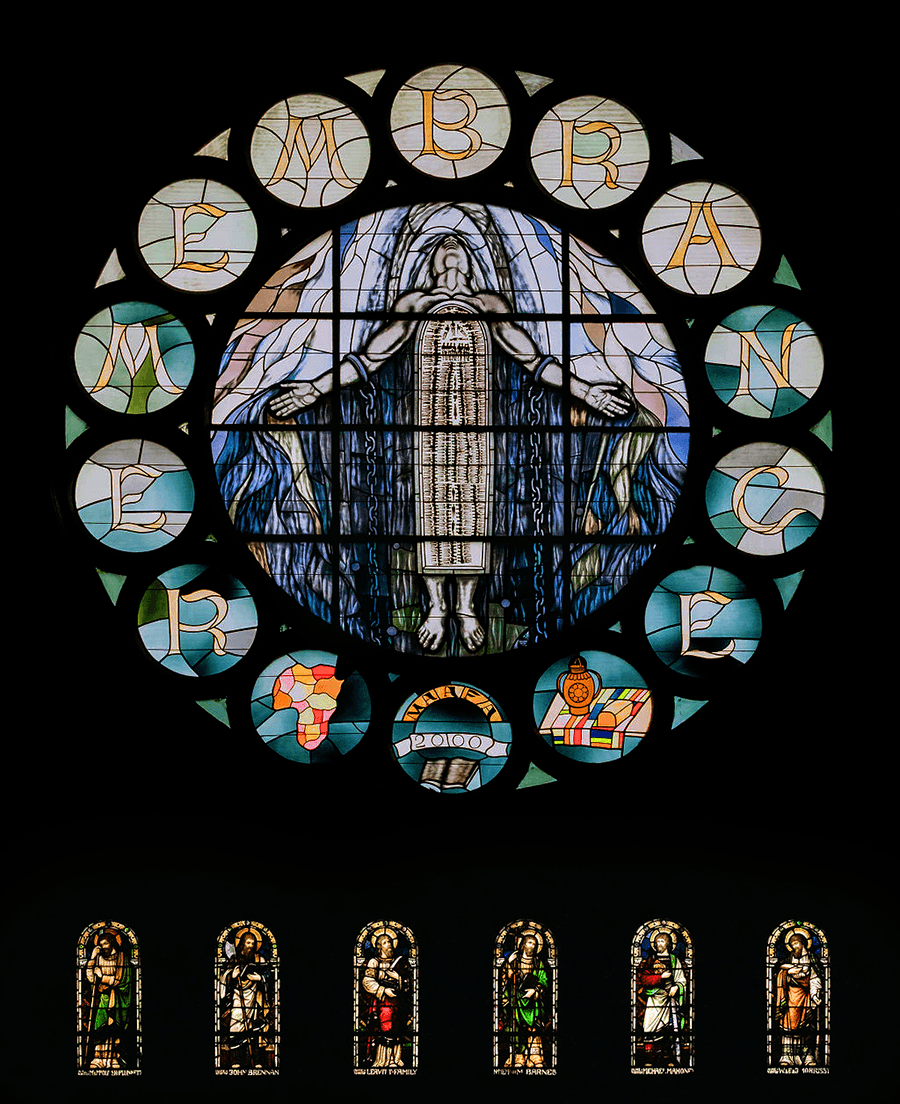
The North Star window represents the great migration of African Americans leaving the American South in the first half of the 20th century. It also commemorates the congregation’s story, with images of its three longest-serving pastors.
The Sankofa Peace window, the most recent addition, takes its name from a word of the Akan people of Ghana meaning “go back and retrieve it.” It memorializes young African Americans killed by violence during the civil rights movement and, more recently, in Chicago neighborhoods. At the same time, it offers a vision of restoration — a dark-skinned Jesus leading children to green pastures and still waters lined with thatched-roof homes.
“It’s about the journey back to reclaiming the value of the village, which is the way we see the Bible,” Hatch said. “More than art, though, it has driven our community ministry [with a vision of] hospitality, family, extended family, mutual support, the centrality of children and the elders, and people in the margins being brought to the center.”

How are the “values of your village” visible or made clear to everyone who walks into your work or home space? How might this clarity enhance hospitality, outreach or stewardship ministries?
New Mount Pilgrim, which has 1,200 members on the rolls, belongs to the American Baptist Churches in the U.S.A. and the Progressive National Baptist Convention. For almost three decades now, members have been transforming the sanctuary — previously home to an Irish Catholic congregation, before redlining and white flight flipped the neighborhood’s demographics — into a space that reflects the ethnicity of its present flock.
When they purchased the building in 1993, they acquired with it years of deferred maintenance. The rose windows in place at that time were buckling, and the congregation had two options: repair them with the existing fair-skinned depictions of Jesus, Mary and other models of faith or create their own stained-glass art reflecting the current congregation’s heritage.
“We had the trilogy in mind 20 years ago, not knowing it would take that long,” Hatch said.
As the members set out to make the sanctuary their own, church leaders found new homes for the existing rose windows. The congregation also raised $35,000 from the sale of a marble altar and used those funds for the roof and other exterior work. They sold two statues to a convent for an additional $8,000 for repairs.
In the late 1990s, Hatch was on sabbatical at Harvard Divinity School when he came across an art book by Tom Feelings, an African American artist from New York, about the transport of African slaves across the Atlantic to the New World. The images in “The Middle Passage” had a deep effect on Hatch, and his congregation would eventually choose one of them for the Maafa window.
Feelings attended New Mount Pilgrim’s 50th anniversary celebration in 2000, at which the window installation was dedicated, and he was so moved by the power of such an image in a church that he refused the money the church had offered him for its use, Hatch said.
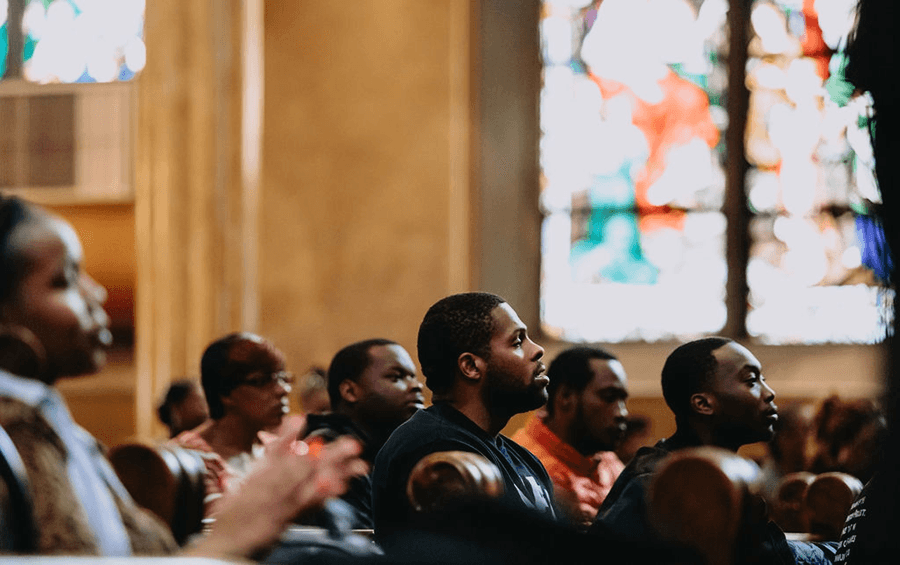
“We became friends after that,” he said. When Feelings died in 2003, Hatch delivered his eulogy.
The schematic of the slave ship Brookes that Feelings incorporated into his art originated with the British abolitionists. In a history of that movement, one of the activists is said to have noted that it never failed to evoke horror.
Centuries later, New Mount Pilgrim’s window is thought to be the largest representation of the slave ship diagram in the world, according to Cheryl Finley, an art historian and the author of “Committed to Memory: The Art of the Slave Ship Icon,” which traces the use of the icon from abolitionist posters to more-recent visual arts and pop culture.
What is it your institution needs to remember in order to be healthy? What grief needs to be confronted or lifted up? Who has been excluded from your institution’s prominent story, based on race, class, gender or sexual orientation?
Finley writes: “Undoubtedly, the crucifixion offers a compelling parallel, for both images have been repeatedly rendered and reworked over the centuries, but they simultaneously embody death and rebirth. The slave ship … is a site of death, of dying Africans, and of new life, of a people who would persevere in the face of slavery and unspeakable cruelty to become a free people who helped define the modern era.”
The Rev. Marshall Hatch Jr., the executive director of the Maafa Redemption Project, a ministry of the church, wrote his master of divinity thesis on the Maafa window. It is a communal symbol, he said, for people who have experienced “the crucifixion of black people in America” through not only slavery but also Jim Crow, mass incarceration, police violence and other oppression.
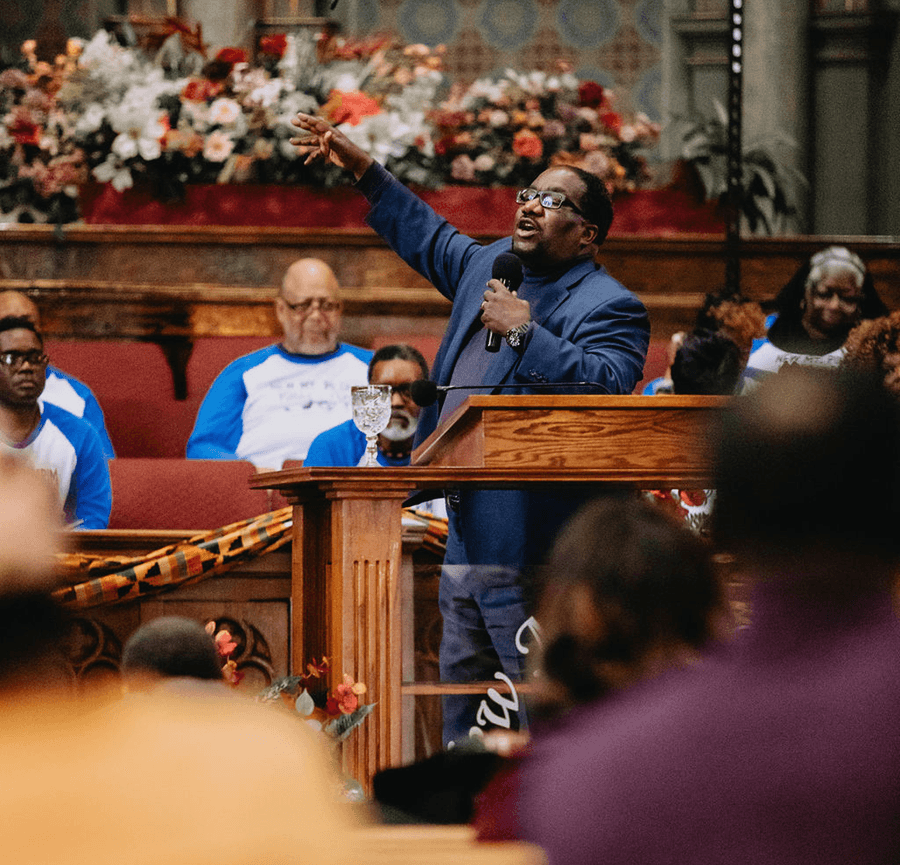
“It’s iconic in that it’s a relationship between the art and the congregation that produced it,” he said. “It invites constant reflection and wrestling over time.”
The North Star window, also completed 20 years ago, bears witness to the journeys of millions of African Americans in the early to mid-20th century who moved to urban areas in the North and West seeking economic opportunity and safety. That history includes the Hatch family’s ancestors, as well as longtime New Mount Pilgrim pastor the Rev. James McCoy, who came to Chicago from the same Mississippi town as Hatch Sr.’s father.
At the North Star window’s center is a scene inspired by the 1970s Alex Haley book and related TV miniseries “Roots,” with the ritual of an African father lifting his newborn child to the heavens and saying, “Behold, the only thing greater than yourself!” The New Mount Pilgrim congregation sees a similar moment embodied in its baby blessings as the infant to be blessed is lifted by the pastor.
“That’s the true north of any community, … the lifting up of the next generation as its hope,” Hatch Jr. said.
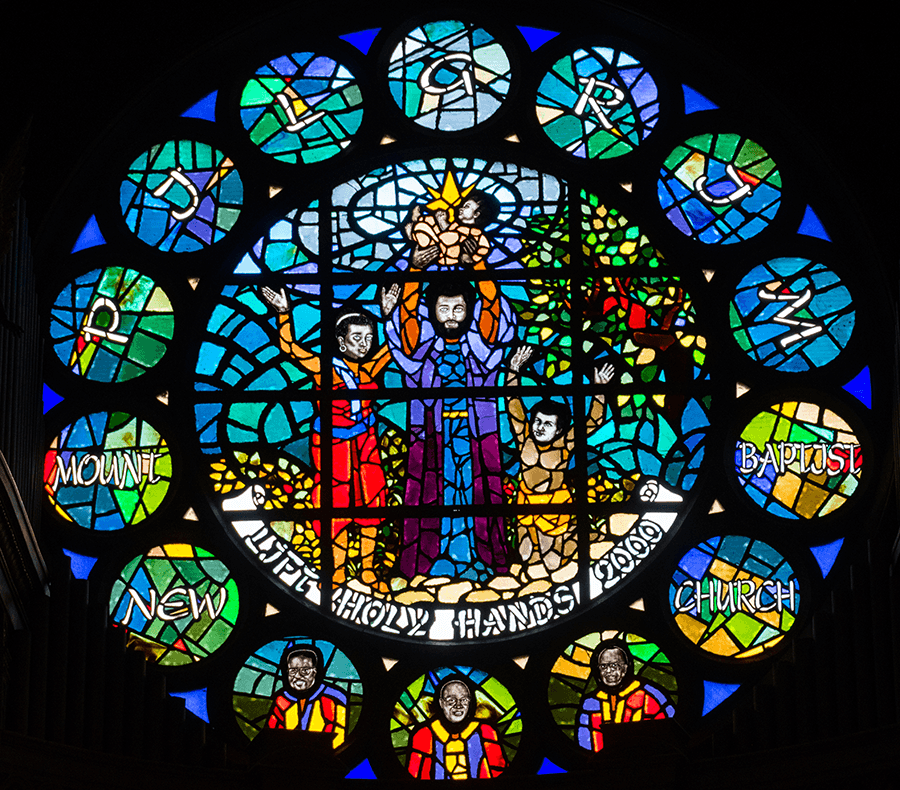
After the first two rose windows were replaced and the necessary maintenance completed, the third window was allowed to remain as clear glass with a sun film for the next 19 years.
Planning for the Sankofa Peace window began in late 2016. New Mount Pilgrim’s youth chose five young people killed by violence in Chicago to be represented in the window, alongside the four girls killed in the 1963 bombing of 16th Street Baptist Church in Birmingham, Alabama. At the times of their deaths, the youth in the window ranged in age from 11 to 17. They are depicted in African garb, surrounding an image of Jesus.
The North Star window speaks to the Sankofa window, Hatch Jr. said, calling the people to create policies that lift children up and prevent violence and tragedy.
“It’s a call to action … to recreate, reconceive, reimagine beloved community,” he said. “It’s the Sankofa window that imagines the day after resurrection.”
Among those in the window the congregation remembers as martyrs is one of its own. Demetrius Griffin Jr., who was christened and baptized at New Mount Pilgrim, was murdered in 2016 not far from the church. He was 15.
Rochelle Sykes, his aunt, also grew up in the congregation and is now on staff. She said his death is agonizing for the family — many of whom are part of the congregation — and the community. To have a family member die “at someone else’s hands — it’s like something has been snatched from you,” she said, looking up from a pew between the Maafa and Sankofa windows. “Sitting in this sanctuary, sometimes it just eases that pain, it eases that ‘Why?’”
Sykes was present when the Sankofa window was installed. It gives her hope to offer children and youth the experience she had of feeling embraced by the congregation, “showing you how God loves you and how to spread that love to others.”
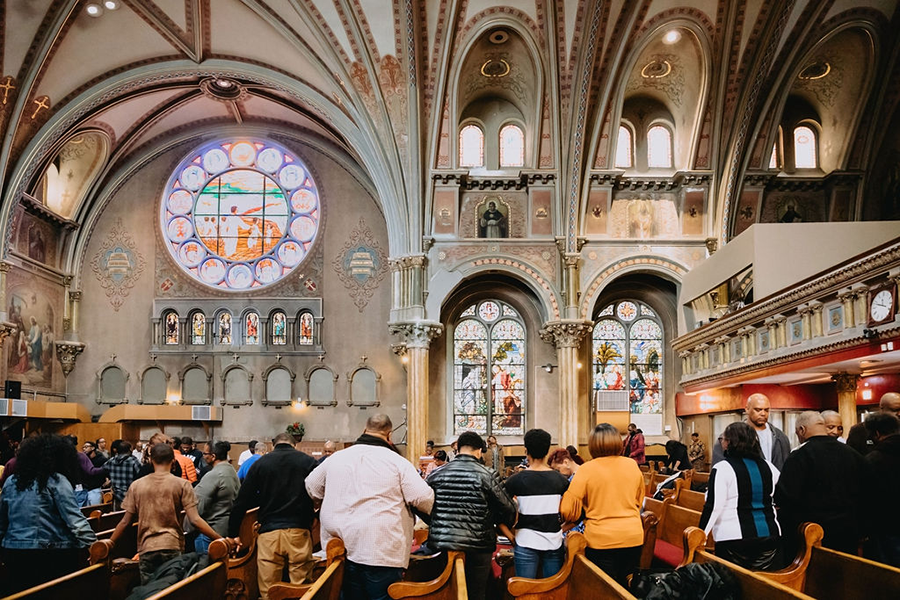
Though Griffin’s murder remains unsolved, that of 17-year-old Laquan McDonald, another of the window’s youth, led to the controversial prosecution and conviction of the Chicago police officer who fatally shot him in 2014. Jason Van Dyke was sentenced in 2019 to less than seven years in prison. Several youth connected to the congregation knew McDonald and asked for his image to be in the window, church leaders said.
Yet McDonald’s death had power far beyond those who knew him, explained the Rev. Stephen G. Ray Jr., the president of Chicago Theological Seminary and of the Society for the Study of Black Religion. Because a Chicago police officer shot McDonald 16 times, and because of the city government’s efforts to cover up Van Dyke’s actions, Ray said, the murder resonates with the vulnerability that young black people feel, faced with structures of white power and violence.
“He then becomes a martyr to all black lives that are lost for no other reason than because they were black,” Ray said. In the context of the larger window, this is the way the community expresses and passes along to future generations that “the lives of all of our children are sacred,” he said.

For all three windows, the church collaborated with Botti Studio of Architectural Arts, a company that has worked on high-profile projects such as St. Patrick’s Cathedral in Manhattan. Botti Studio designers helped New Mount Pilgrim leaders adapt images they had in mind and translate them into stained glass.
The church raised more than $110,000 in donations from within and outside the congregation for the final window. It was dedicated in 2019, the 400th anniversary of the first African enslaved people’s reaching the English colony of Virginia.
In New Mount Pilgrim’s sanctuary, the newer art lifting up black life and the resilience of black people stands in contrast to the preexisting stained-glass windows and murals closer to the floor, which depict Jesus, saints and others as European in appearance. For the church’s black congregants, appreciating such devotional art requires an ability learned growing up in a white supremacist society, Ray said.

“Part of what the system of white supremacy does is it gives black people the capacity to see the humanity of white people even if that’s not reciprocated,” he said.
As a result, black people can look at white depictions of Jesus, the apostles and other models of faith and see through the white skin to the humanity, he said. Black Christians don’t make a one-to-one correspondence between a fair-skinned Jesus and the real Jesus. In contrast, many white Christians have simply looked at ancient models of faith depicted with European features “like a stylized photograph,” he said.
The rose windows are set in a building that also still reflects its white, Roman Catholic history. Do you think this contrast would be disruptive or constructive for worshippers? What contrasts do you experience as you worship or work?
These tensions exist across the country, especially with respect to the role and function of stained glass, Ray said. Since the great migration, there has been a national phenomenon in black church life of sacred spaces, both synagogues and churches, not having been built by the black congregations, he said.
Some Afrocentric congregations, such as Trinity United Church of Christ on the South Side of Chicago, constructed their own buildings rather than worship with religious art created by European congregations.
Though the transformation of New Mount Pilgrim’s sanctuary is incomplete, the messages of the rose windows resound in the space.
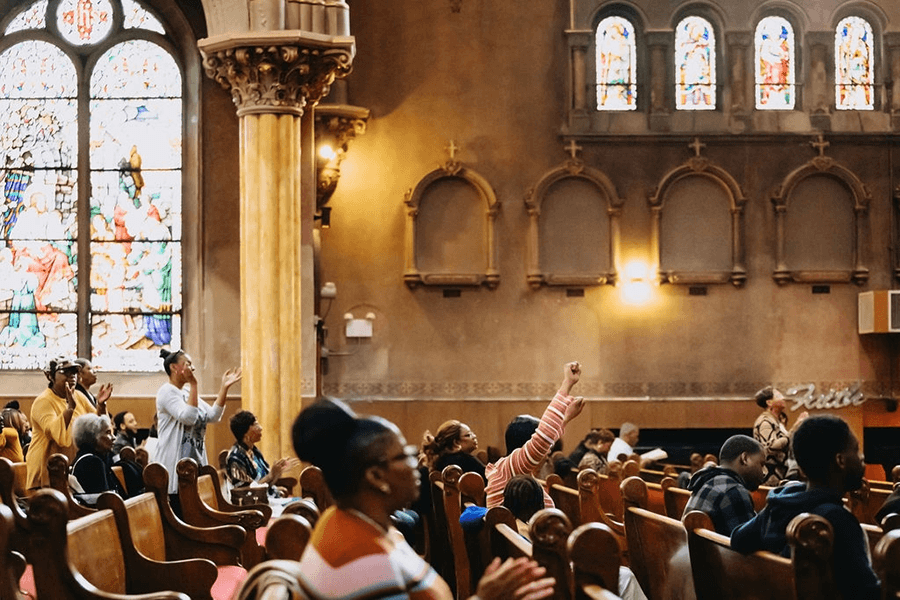
Robert Ervin, a deacon, said that when he looks at the windows, “it humbles you seeing where you came from and all we’ve been through.”
Ervin noted that the bird’s head in the Sankofa window is turned around and reaching toward its back, symbolizing that “we have to look to the past and glean from it in order to move forward.”
Questions to consider
Questions to Consider
- The members of New Mount Pilgrim Missionary Baptist Church are “long-practiced with telling their story through art.” What kinds of art — visual, musical, dramatic, etc.– tell the story of your institution?
- How does your church or organization “honor both pain and promise” in its history and future? In what ways does it take part in the “continuation of the liberation narrative of God”?
- How are the “values of your village” visible or made clear to everyone who walks into your work or home space? How might this clarity enhance hospitality, outreach or stewardship ministries?
- What is it your institution needs to remember in order to be healthy? What grief needs to be confronted or lifted up? Who has been excluded from your institution’s prominent story, based on race, class, gender or sexual orientation?
- The rose windows are set in a building that also still reflects its white, Roman Catholic history. Do you think this contrast would be disruptive or constructive for worshippers? What contrasts do you experience as you worship or work?



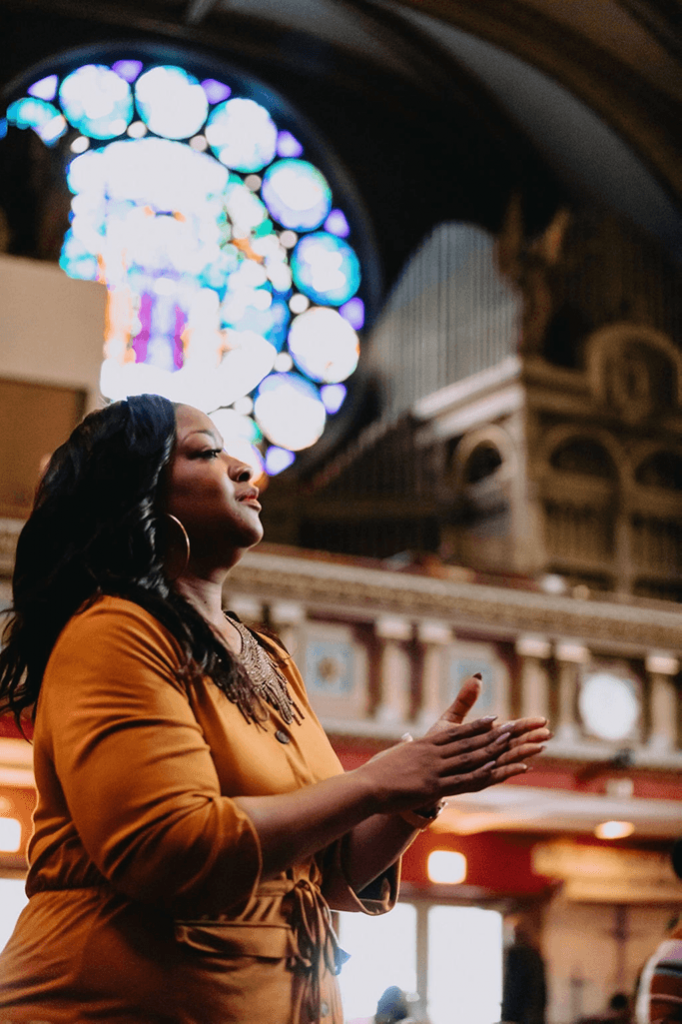
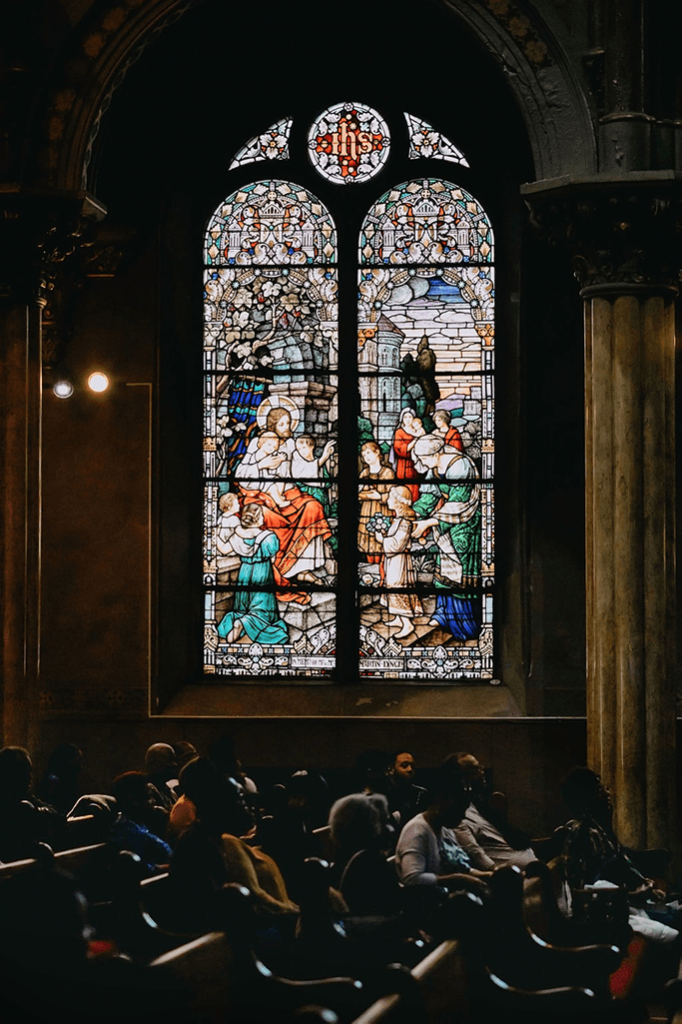

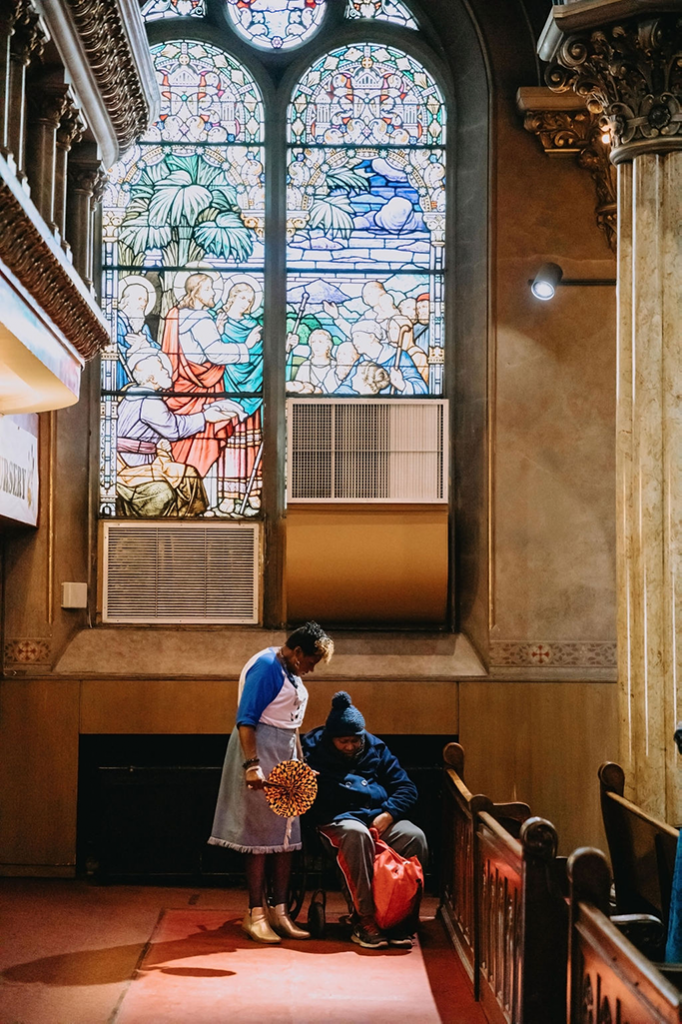


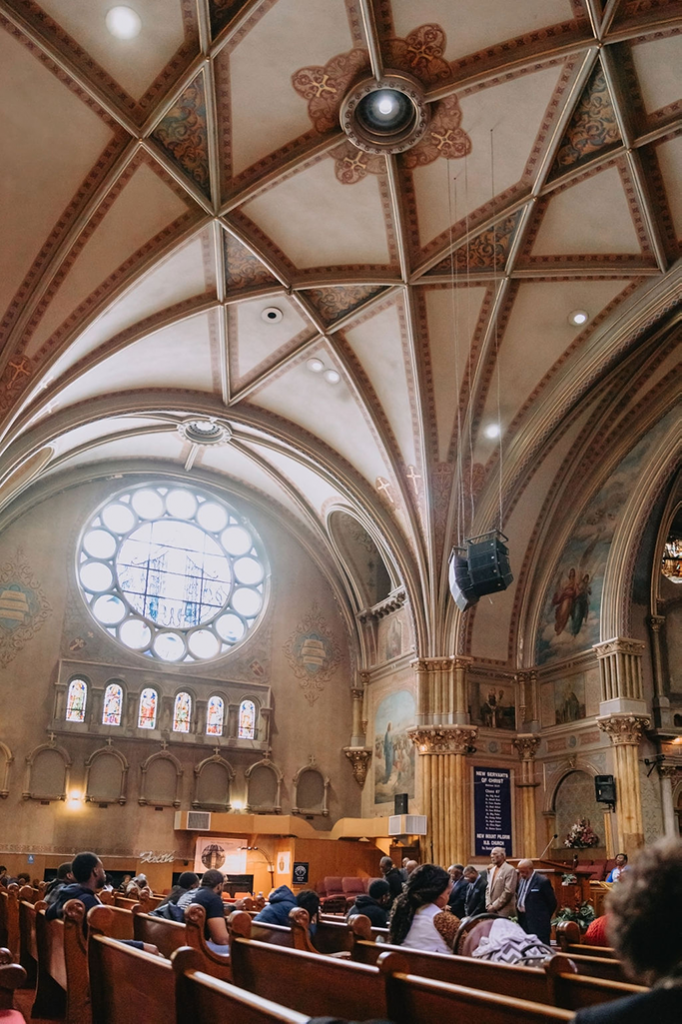
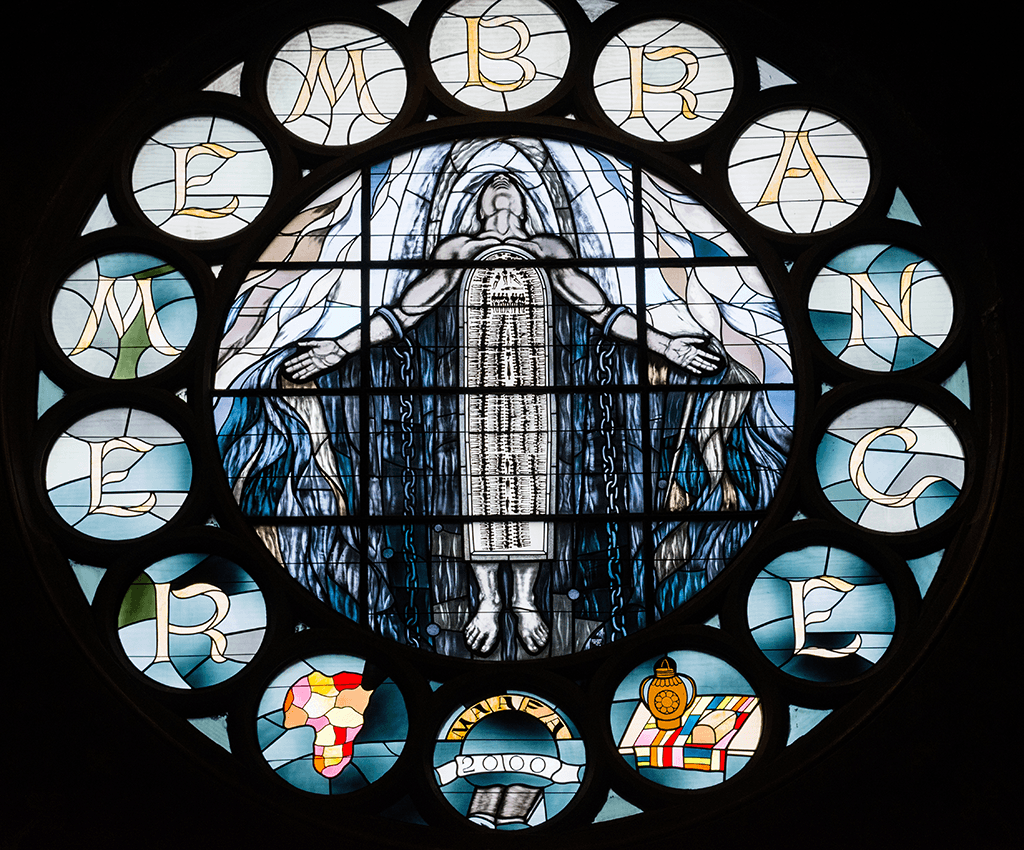

Share